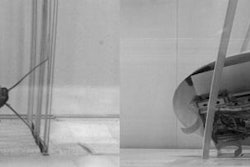Sick of driving to work for your daily commute? How does the notion of flying in sound? Chinese drone company EHang believes it has the solution for the quicker, and perhaps even enjoyable, commute.
At the Wednesday edition of CES 2016, the company revealed the fully electric EHang 184, which it claims is the first-ever Autonomous Aerial Vehicle (AAV) designed for human transportation. In the ‘184,’ the ‘1’ symbolizes the passenger, the ‘8’ relates to the eight propellers and the ‘4’ pertains to the four arms.
The company claims that passengers wouldn’t need a pilot’s license to travel since the EHang 184 is fully automated, navigating via the company’s real-time flight command center, which is yet to be completed. The various flight control systems on the AAV make use of data collected by sensors over the course of the flight, which provides the passengers with the fastest and safest route available. In fact, all the passenger has to do is enter the destination they’d like to fly to via a smartphone app.
Powered by eight motors that can produce a maximum output of 106W, the 440-pound EHang 184 can transport a passenger weighing up to 220 pounds. The maximum flight distance for one trip is 23 minutes at sea level at an average speed of about 62 miles per hour, or 100 km/hr.
EHang, which was the sole developer of the 184, said in a press release that the 184 will not only change the transportation industry, but also the shipping, medical care and retail industries.
"It's been a lifetime goal of mine to make flight faster, easier and more convenient than ever. The 184 provides a viable solution to the many challenges the transportation industry faces in a safe and energy efficient way," said EHang CEO Huazhi Hu in the press release. "I truly believe that EHang will make a global impact across dozens of industries beyond personal travel. The 184 is evocative of a future we've always dreamed of and is primed to alter the very fundamentals of the way we get around."
One of the immediate questions that is evoked by the unveiling of an interesting development such as the EHang 184 is “how safe is it?” According to EHang, the AAV’s greatest quality as it pertains to safety is its ability to eliminate any possibility of human error. The company also added backups to all flight systems, meaning that if a component does indeed fail, there will be multiple prepared backups.
The company also developed a scheme for the 184 known as the “Fail-Safe System.” Should a component break down or the AAV be damaged mid-flight by something like hail or a bird, the system would cause the aircraft to enter a phase of preventative measures. If something like a small bird struck the AAV, causing rather insignificant damages, the system would deem the 184 to be in good enough shape for flight. If more significant damage is caused, they system would decide to land the AAV. The company claims that the AAV can fly during thunderstorms or other forms of extreme weather, though it did add that its command center can prevent any AAV from taking off due to safety concerns.
Should the passenger for some reason feel unease about their flight and want to abort, they could click a button that would stop the flight path and put the 184 in a hovering state. The company also encrypted all of the AAV’s systems and added an independent key.
Taking off from a rather compact space? No worries. The EHang 184 takes off and lands vertically. Its four arms can be folded so that the AAV can fit in a car-sized parking spot. The 1.5-meter-tall AAV features a gull-wing door and trunk. Its power system, which is composed of the aforementioned four arms and eight propellers, is located on the bottom of the aircraft. The 184’s seat mirrors a F1 racing car seat. In front of the seat is a tablet counsel. To enhance the pleasure of traveling, the AAV’s cabin also has automatic air-conditioning and 4G Wi-Fi.
“This first glimpse of the EHang 184 offers just a small sense of its massive potential, even beyond transporting passengers,” the company said. “It promises limitless possibilities and will undoubtedly impact the way we all travel in profound ways.”






















